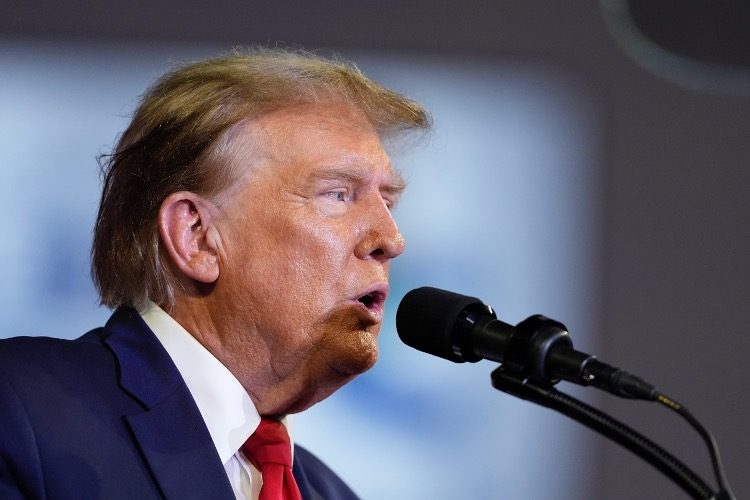
Former U.S. President Donald Trump will seek to enforce a series of strict restrictions on immigration — including detention camps for migrants near the country’s southern border — should he be reelected to the White House later this year, per a report by Axios.
Trump has made immigration reform and the boosting of border-security protocols major campaign pledges before a likely rematch with incumbent Democrat President Joe Biden in November. Should he win the presidency, Trump will tap a range of executive powers to deport “millions” of people as part of his immigration crackdown, the outlet said on February 11.
Quoting an unnamed source with knowledge of the plans, Axios reported that a second Trump administration would likely see U.S. immigration officials, the FBI, and various other executive arms of the government to conduct mass deportations of undocumented immigrants.
Besides, fast-track deportations would be expanded to individuals found to have illegally crossed the border and who are unable to prove they have been living in the United States for at least two years, the report added.
Furthermore, Trump would employ legislation more than two centuries old that would permit the rounding up and immediate deportation of immigrants with criminal histories, the publication asserted. Large sites would also be built to hold migrants awaiting deportation in areas close to the border with Mexico.
To boot, Axios also pointed out that Trump would likely reimpose the so-called Muslim ban that restricts the entry into the United States of people from some Muslim-majority countries. Biden had previously rescinded the legislation when he succeeded Trump in 2021.
In December, Trump said at a campaign stop in New Hampshire that immigrants “are poisoning the lifeblood of our country” — rhetoric that was seized upon by the Biden campaign, who claimed that he had “parroted Adolf Hitler,” who had used similar language in Mein Kampf.
Axios elaborated that Trump’s immigration agenda would likely receive resistance from Democratic lawmakers, as well as from Latino advocacy groups and “sanctuary cities” — the title referring to areas that impede federal immigration enforcement.
Financial analysts have claimed that removing undocumented migrants from the workforce would imperil the U.S. economy, as well as stifle policies meant to ease inflation, Axios said.
Trump adopted a similarly stringent stance toward immigration during his four-year term in the White House between 2017 and 2021, although he deported fewer people during his presidency than his predecessor, the leftist Barack Obama.
Last month, a Harvard CAPS-Harris poll found that immigration is a major point of concern for U.S. voters, ahead of inflation and the economy.
The number of people arrested for crossing into the United States from Mexico illegally reached an all-time high of 249,785 in December, according to U.S. Immigration and Customs Enforcement.
Also, Trump argued that the rest of NATO has to send as much aid to Ukraine as the United States does, after claiming he once threatened to withhold military protection from European nations that do not “pay [their] bills.”
Trump’s rhetoric on the campaign trail was in sync with his NATO-skeptic stance during his term in the White House. After those comments, the bloc’s Secretary General Jens Stoltenberg accused the politician of putting “American and European soldiers at increased risk” by challenging NATO’s mutual defense guarantee.
Trump also broached the NATO issue on February 12 on social media, boasting about twisting the arms of allies during his term in office.
“When I told the 20 Countries that weren’t paying their fair share that they had to PAY UP, and said without doing that you will not have U.S. Military Protection, the money came rolling in,” Trump’s post on his Truth Social platform read. “It was a beautiful sight to see.”
“NATO HAS TO EQUALIZE, AND NOW. THEY WILL DO THAT IF PROPERLY ASKED,” he added in all caps, alluding to Ukraine aid.
The trans-Atlantic alliance has 31 member states, only two of which are based in North America. North Macedonia joined in 2020 as the 30th ally.
The organization suggests that each country spend at least two percent of GDP on military purposes. Some of the wealthiest members, including Germany, France, and Italy, have not met the target for decades.
EU nations did increase their military spending during Trump’s presidency as hostilities with Russia increased, something Trump has taken credit for as a personal diplomatic achievement.
Speaking on February 10 at a rally in South Carolina, Trump recalled an encounter during his presidential term when he allegedly told a European leader that unless that nation met the spending threshold, the United States would consider it “delinquent” and not defend it in the event of a Russian attack.
“In fact I would encourage them to do whatever the hell they want. You’ve gotta pay,” he recalled telling the ally.
Biden’s White House termed the remarks as “appalling and unhinged.”
Russia denies having any aggressive intentions regarding NATO, despite deeming it a hostile organization pandering to U.S. interests. President Vladimir Putin said in an interview with U.S. journalist Tucker Carlson last week that Western politicians’ accusations of Russia are meant “to intimidate their own population with an imaginary Russian threat.”
Meanwhile, Washington’s ambassador to the alliance said on Tuesday, February 13, that Ukraine is unlikely to be invited to join NATO this year, notwithstanding last year’s repeated promises of full membership.
Speaking to journalists before this week’s meeting of the U.S. military bloc’s defense ministers, Julianne Smith was asked what to expect from this summer’s NATO summit in Washington.
Kyiv officially applied to join NATO in autumn of 2022, having enshrined accession to the trans-Atlantic alliance in its constitution back in 2019, hailing NATO membership as a strategic foreign policy goal.
Notably, Smith maintained the official position that “Ukraine’s future is in the NATO Alliance” and underscored that NATO continues to focus on supporting Kyiv and ensuring that it can “prevail on the battlefield” in its conflict with Russia.
However, she warned, “As for the summit this summer, I do not expect the Alliance to issue an invitation at this juncture.” Smith said she expects a pledge from member states to “move closer to Ukraine and that we are taking concrete steps to serve as a bridge between where we are now and that full-fledged membership.”
“All of us will continue to support [Ukraine] for as long as it takes,” the diplomat stressed.
Last week, Britain’s envoy to NATO, David Quarrey, also cautioned that Kyiv should not expect considerable progress on its membership bid in the near future. Speaking to Politico, he claimed Kyiv is “getting closer all the time” but that the “situation on the ground” prevents any “big leaps” toward membership.
Based on a Foreign Policy magazine report in January, citing anonymous officials, neither Washington nor Berlin currently want Kyiv to join the bloc, fearing a potential direct confrontation with Moscow. Such worries have also been voiced by some NATO members, especially Hungary and Slovakia.



